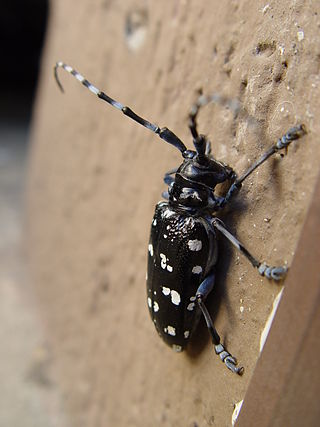Baroque chess is a chess variant invented in 1962 by Robert Abbott. In 1963, at the suggestion of his publisher, he changed the name to Ultima, by which name it is also known. Abbott later considered his invention flawed and suggested amendments to the rules, but these suggestions have been substantially ignored by the gaming community, which continues to play by the 1962 rules. Since the rules for Baroque were first laid down in 1962, some regional variation has arisen, causing the game to diverge from Ultima.

The Asian long-horned beetle, also known as the starry sky, sky beetle, or ALB, is native to the Korean Peninsula, northern and southern China, and disputably in northern Japan. This species has now been accidentally introduced into the eastern United States, where it was first discovered in 1996, as well as Canada, and several countries in Europe, including Austria, France, Germany, Italy and UK.

The longhorn beetles (Cerambycidae), also known as long-horned or longicorns, are a large family of beetles, with over 35,000 species described.

Anoplophora chinensis, the citrus long-horned beetle, is a long-horned beetle native to Japan, China, Korea, Taiwan and Southeast Asia where it is considered a serious pest. This beetle has invaded several countries in Europe, including Italy, Switzerland, Turkey, France, Germany, and Croatia.

The Real Bruce Lee, also known as Last Fist of Fury, is a 1977 martial arts documentary.

Ranitomeya imitator, is a species of poison dart frog found in the north-central region of eastern Peru. Its common names include mimic poison frog and poison arrow frog, and it is one of the best known dart frogs. It was discovered in the late 1980s by Rainer Schulte who later split it up into more subspecies; describing each as a specific color morph, and sometimes having a separate behavioral pattern. The acoustics, morphs, and behavior of the species have been extensively researched.
Trobar clus, or closed form, was a complex and obscure style of poetry used by troubadours for their more discerning audiences, and it was only truly appreciated by an elite few. It was developed extensively by Marcabru and Arnaut Daniel, but by 1200 its inaccessibility had led to its disappearance. Among the imitators of Marcabru were Alegret and Marcoat, who claimed himself to write vers contradizentz, indicative of the incomprehensibility of the trobar clus style. Below is a sample of the style from Marcoat's sirventesMentre m'obri eis huisel, wherein the poet himself remarks on his moz clus :
The Great Imitator is a phrase used for medical conditions that feature nonspecific symptoms and may be confused with a number of other diseases. The term connotes especially difficult differential diagnosis (DDx), especial potential for misdiagnosis, and the protean nature of some diseases. Most great imitators are systemic in nature or have systemic sequelae, and an aspect of nonspecific symptoms is logically almost always involved. In some cases, an assumption that a particular sign or symptom, or a particular pattern of several thereof, is pathognomonic turns out to be false, as the reality is that it is only nearly so.
The squirrel-toothed rat, also known as the New Guinea giant rat, powerful-toothed rat, uneven-toothed rat, or narrow-toothed giant rat, is a species of rodent in the family Muridae. It is the only species in the genus Anisomys and is found in New Guinea.

The imitator salamander is a species of salamander in the family Plethodontidae. It is endemic to the Appalachian Mountains in the southeastern United States.
The imitator goshawk or imitator sparrowhawk is a species of bird of prey in the family Accipitridae. It is found on the islands of Bougainville, Choiseul and Santa Isabel in the Solomon Islands archipelago. Its natural habitats are subtropical or tropical moist lowland forest and subtropical or tropical moist montane forest.
Goshawk may refer to several species of birds of prey, mainly in the genus Accipiter:
Copelatus imitator is a species of diving beetle. It is part of the genus Copelatus in the subfamily Copelatinae of the family Dytiscidae. It was described by Bilardo & Rocchi in 2002.

White-faced capuchin, or white headed capuchin, can refer to either of two species of gracile capuchin monkey:

Anoplophora is a genus of beetles in the longhorn beetle family (Cerambycidae). They are native to Asia. Most are large and colorful and thus are depicted in artwork and sought after by beetle collectors. The genus also includes several notorious pest insects.

Anoplophora horsfieldii is a species of beetles in the longhorn beetle family (Cerambycidae).
Anoplophora quadrifasciata is a species of beetle in the family Cerambycidae. It was described by Stephan von Breuning in 1961.

Anoplophora elegans is a species of beetles in the longhorn beetle family (Cerambycidae). It was found by Gahan in the Mine District in Upper Burma (Myanmar). It is distributed in South East Asia.

Anoplophora medenbachii is a species of beetles in the family Cerambycidae. It is distributed in Southeast Asia.

Anoplophora zonator is a species of beetle in the family Cerambycidae. It is distributed in Borneo, Malaysia, Thailand, Laos, and Myanmar.











